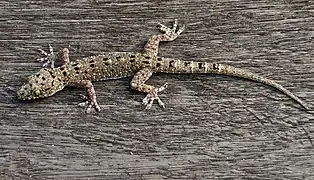
| Règne | Animalia |
|---|---|
| Embranchement | Chordata |
| Classe | Reptilia |
| Sous-classe | Lepidosauria |
| Ordre | Squamata |
| Sous-ordre | Sauria |
| Infra-ordre | Gekkota |
- Gekkoninae Oppel, 1811
Les Gekkonidae sont une famille de geckos. Elle a été étudiée pour la première fois par Nicolaus Michael Oppel en 1811.
Description
Ces geckos partagent en général les caractéristiques suivantes (mais il y a des exceptions) :
- possibilité de grimper sur toutes les surfaces grâce à leurs coussinets adhérents, les setæ pour les espèces arboricoles principalement ;
- absence de paupières mobiles ;
- mœurs principalement nocturnes (à quelques exceptions près, dont les Phelsumes, justement appelés Gecko diurne ;
- majoritairement insectivores, mais certaines espèces consomment également des fruits et nectars, voire de petits mammifères ou reptiles pour les plus gros ;
- capacité de vocaliser parfois de façon spectaculaire ;
- une bonne ouïe.
Liste des genres
Selon The Reptile Database (12 juin 2017)[1] :
- Afroedura Loveridge, 1944
- Afrogecko Bauer, Good & Branch, 1997
- Agamura Blanford, 1874
- Ailuronyx Fitzinger, 1843
- Alsophylax Fitzinger, 1843
- Altiphylax Yeriomtschenko & Shcherbak, 1984
- Blaesodactylus Boettger, 1893
- Bunopus Blanford, 1874
- Calodactylodes Strand, 1926
- Chondrodactylus Peters, 1870
- Christinus Wells & Wellington, 1984
- Cnemaspis Strauch, 1887
- Colopus Peters, 1869
- Crossobamon Boettger, 1888
- Cryptactites Bauer, Good & Branch, 1997
- Cyrtodactylus Gray, 1827
- Cyrtopodion Fitzinger, 1843
- Dixonius Bauer, Good & Branch, 1997
- Ebenavia Boettger, 1877
- Elasmodactylus Boulenger, 1895
- Geckolepis Grandidier, 1867
- Gehyra Gray, 1834
- Gekko Laurenti, 1768
- Goggia Bauer, Good & Branch, 1997
- Hemidactylus Gray, 1825
- Hemiphyllodactylus Bleeker, 1860
- Heteronotia Wermuth, 1965
- Homopholis Boulenger, 1885
- Kolekanos Heinicke, Daza, Greenbaum, Jackman & Bauer, 2014
- Lepidodactylus Fitzinger, 1843
- Luperosaurus Gray, 1845
- Lygodactylus Gray, 1864
- Matoatoa Nussbaum, Raxworthy & Pronk, 1998
- Mediodactylus Szczerbak & Golubev, 1977
- Microgecko Nikolski, 1907
- Nactus Kluge, 1983
- Narudasia Methuen & Hewitt, 1914
- Pachydactylus Wiegmann, 1834
- Paragehyra Angel, 1929
- Paroedura Günther, 1879
- Parsigecko Safaei-Mahroo, Ghaffari & Anderson, 2016
- Perochirus Boulenger, 1885
- Phelsuma Gray, 1825
- Pseudoceramodactylus Haas, 1957
- Pseudogekko Taylor, 1922
- Ptenopus Gray, 1866
- Ptychozoon Kuhl & van Hasselt, 1822
- Ramigekko Heinicke, Daza, Greenbaum, Jackman & Bauer, 2014
- Rhinogecko de Witte 1973
- Rhoptropella Hewitt, 1937
- Rhoptropus Peters, 1869
- Stenodactylus Fitzinger, 1826
- Tenuidactylus Shcherbak & Golubev, 1984
- Trachydactylus Haas & Battersby, 1959
- Tropiocolotes Peters, 1880
- Urocotyledon Kluge, 1983
- Uroplatus Dumeril, 1806
Phylogénie
Pyron, et al. (2013)[2] présente la classification suivante des genres de Gekkonidae, basée sur la phylogénétique moléculaire.
| Gekkonidae |
| ||||||||||||
Publication originale
- Oppel, 1811 : Die Ordnungen, Familien und Gattungen der Reptilien, als Prodrom einer Naturgeschichte derselben. J. Lindauer, München (texte intégral).
Liens externes
- (en) Référence Animal Diversity Web : Gekkonidae (consulté le )
- (en) Référence Catalogue of Life : Gekkonidae (consulté le )
- (en) Référence Fauna Europaea : Gekkonidae (consulté le )
- (fr+en) Référence ITIS : Gekkonidae (consulté le )
- (en) Référence NCBI : Gekkonidae (taxons inclus) (consulté le )
- (en) Référence Reptarium Reptile Database : Gekkonidae (consulté le )
- (en) Référence Paleobiology Database : Gekkonidae Gray 1825 (consulté le )
- (en) Référence UICN : taxon Gekkonidae (consulté le )
- (en) Référence Wild Herps : photographies de Gekkonidae (consulté le )
Notes et références
- ↑ Reptarium Reptile Database, consulté le 12 juin 2017
- ↑ Pyron, R Alexander, Frank T Burbrink and John J Wiens. 2013. A phylogeny and revised classification of Squamata, including 4161 species of lizards and snakes. BMC Evolutionary Biology 2013 13:93. DOI 10.1186/1471-2148-13-93